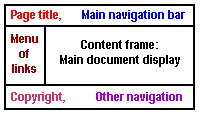In the previous example, Checkpoint 12.1, we used the "title" attribute of the FRAME element to briefly explain the function of each frame. In some cases, you might feel that the purpose or content of your FRAME or FRAMESET may be too complicated to explain in just a few words. In those cases, we encourage you to use the "longdesc" attribute of the FRAME element to provide a link to a document that contains a complete description of the complex frame, or of the relationships between the various frames, e.g.:
<FRAME src="main.htm" longdesc="maindesc.htm" title="Main content frame.">
The "longdesc" file for this particular FRAME design might look like this:

There are four frames in this example. The frame along the top of the page is for the page title and primary navigation bar. The narrow frame (center, left) is to be used for the List of links. The largest frame (center, right) is where the content of the document chosen from the List of links will appear. The frame across the bottom of the page is for the copyright, secondary navigation and other constant information.
 To Checkpoints for Guideline 12.
To Checkpoints for Guideline 12.Next slide: Example for Checkpoint 12.3

